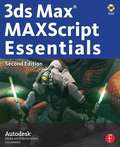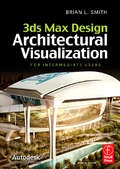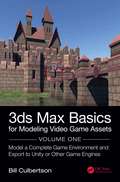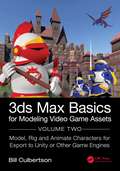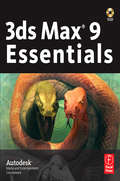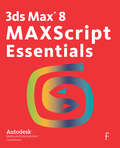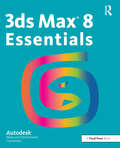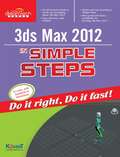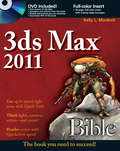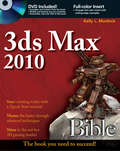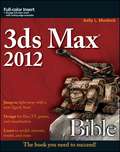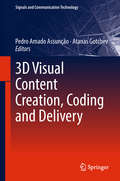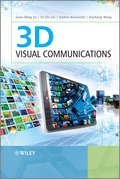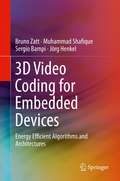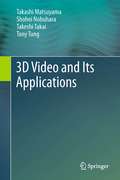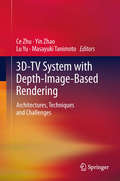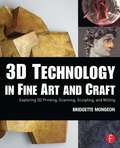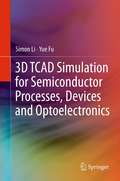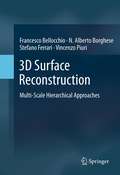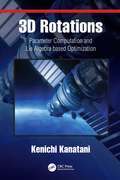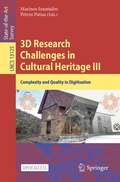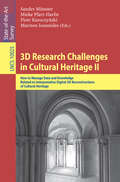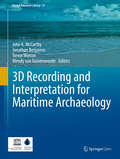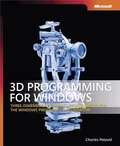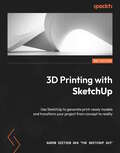- Table View
- List View
3ds Max MAXScript Essentials
by AutodeskWrite your own MAXScript functions and utilities to automate repetitive tasks and create custom tools and UI elements. Beginning with an introduction to essential programming concepts, you learn the MAXScript basics that include cloning objects, MAX commands, toolbar access, picking scene nodes, picking points, and using the mousetrack command and painter interface. Real-world tutorial examples are provided throughout the book to demonstrate how to use the MAXScript techniques in your own production environment.
3ds Max Design Architectural Visualization: For Intermediate Users
by Brian L. SmithLearn time-saving techniques and tested production-ready tips for maximum speed and efficiency in creating professional-level architectural visualizations in 3ds Max. Move from intermediate to an advanced level with specific and comprehensive instruction with this collaboration from nine different authors from around the world. Get their experience and skills in this full-color book, which not only teaches more advanced features, but also demonstrates the practical applications of those features to get readers ready for a real production environment. Fully updated for the most recent version of 3ds Max.
3ds Max Basics for Modeling Video Game Assets: Model a Complete Game Environment and Export to Unity or Other Game Engines
by William CulbertsonA textbook for learning 3d modeling fundamentals, this step-by-step lesson book develops the readers modeling skills through a series of modeling exercises creating modules for a medieval castle environment. As the text introduces new modeling skills it additionally calls on the reader to perform repetitive tasks, reinforcing skills learned in the process. The content is presented as if the reader is in a working video game studio, being responsible for researching asset design, providing the team with placeholder assets, and final model assets that are unwrapped and custom textured. Upon completion of the modeling projects, the modeled environment is exported to the Unity game engine for use in a real game environment, Although the text uses Autodesk 3ds Max for the modeling program, the principals are transferable to other major modeling programs. Key Features: The goal of this book is to teach the fundamentals of 3d modeling video game assets in a simplified, logical progression, optimized for learning at a beginner level. This series of modeling exercises is the result of having taught over one thousand video game students the fundamentals of 3d modeling. Often, teachers are not fully trained in teaching the concepts of 3d modeling. This text, written for self-paced learning helps those instructors. Includes instructions and project files for exporting the finished project environment into a 3d game engine, Unity. Appendices include additional 3ds Max tool instructions. A companion site includes working 3ds Max project files for Chapters, a 3ds Max user interface and 3ds Max short cut keys and more.
3ds Max Basics for Modeling Video Game Assets: Volume 2: Model, Rig and Animate Characters for Export to Unity or Other Game Engines
by William CulbertsonAs a textbook for learning the fundamentals of modeling, rigging and animating 3D-modeled characters for use in video games, this step-by-step lesson book builds on the reader's modeling skills acquired from reading Volume I. The reader will model characters for the Castle Environment created in Volume I, which will be rigged using the Character Animation Toolkit (CAT) in 3ds Max and animated with game moves. The Skin Modifier is used for associating the meshes to the rigs and the characters are then exported to the Unity game engine and integrated into the Castle Scene with a Third Person Character camera. As the text introduces new modeling skills, it additionally calls on the reader to perform repetitive tasks, reinforcing skills learned in the process. The content is presented as if the reader is in a working video game studio, being responsible for researching asset design and providing the team with placeholder assets and final model assets that are unwrapped and custom textured using both box mapping and the 3ds Max Quick Peel tool. Although the text uses Autodesk 3ds Max for the modeling program, the principles are transferable to other major modeling programs. Key Features: The goal of this book is to teach the fundamentals of 3D modeling video game characters in a simplified, logical progression optimized for learning at a beginner level. Rigging principles (Linking, Inverse Kinematics [IK], Forward Kinematics [FK], Skin Deformation, Weighting Vertices and more) are introduced in a gradual progression to allow maximum comprehension and retention. This series of modeling exercises is the result of having successfully taught over 1000 video game students the fundamentals of 3D modeling. This complete, clearly written and concise text is written for self-paced learning, helping those instructors who might not be fully trained in 3D modeling and those interested in self-teaching. Includes instructions and project files for exporting the finished project environment into the 3D game engine, Unity. A companion site (www.3dsMaxBasics.com) includes working 3ds Max project files for chapters, notes and corrections, a 3ds Max user interface, 3ds Max shortcut keys and more.
3ds Max 9 Essentials: Autodesk Media and Entertainment Courseware
by AutodeskBring 3D film effects to the big screen. Generate realistic characters for a top-selling game. Create rich and complex design visualization. Autodesk® 3ds Max® 9 lets you maximize your productivity and tackle challenging animation projects. And this book, developed by Autodesk insiders, lets you master the essential tools and techniques. Learn how to use 3ds Max 9 confidently in a production environment. Each chapter of this book has a series of theory lessons and one lab. The theory lessons introduce you to the functional areas of 3ds Max and explain these features with short simple examples. The lab demonstrates a practical application of the theory. Combined, each chapter delivers a sound understanding of the functions, features and principles behind 3ds Max 9, and shows you how to apply this knowledge to real-world situations.
3ds Max 8 MAXScript Essentials
by AutodeskWrite your own MAXScript functions and utilities to create custom tools and UI elements, and automate repetitive tasks. Demonstrated techniques include the creation of objects, arrays, collections, control structures, parametric objects, and the construction of UI elements. The companion CD-ROM contains media files that allow you to practice the techniques with real-world examples demonstrating how you can use then in a production environment.
3ds Max 8 Essentials: Autodesk Media and Entertainment Courseware (Autodesk Media And Entertainment Courseware Ser.)
by AutodeskWelcome to the Autodesk Media and Entertainment Official Training Courseware for 3ds Max 8 software! Consider this book an all-access pass to the production and training experience of Autodesk developers and training experts. Written for self-paced learning or instructor-led classroom training, the manual will teach you the fundamentals of using 3ds Max 8. The book is organized into sections dedicated to animation, modelling, materials, lighting and rendering. Each section covers basic theory, and then includes exercises for hands-on demonstration of the concept. By the end of the book, you will have mastered the basics and moved onto full-length projects. Flexibility is built in, so that you can complete the tutorials in the way that works best for you. Complete the book and you will be a seasoned 3ds Max pro, ready to work confidently in a production environment.
3ds Max 2012 In Simple Steps
by Kogent Learning Solutions Inc3Ds Max 2012 In Simple Steps Author: Kogent Learning Solutions Inc.
3ds Max 2011 Bible (Bible #719)
by Kelly L. MurdockUpdated version of the bestselling 3ds Max book on the market Used by more than 150,000 people, and the winner of more than 65 industry awards, 3ds Max is the world's most popular animation modeling and rendering software for film, television, video games, and design visualization. 3ds Max Bible is the world’s most popular book for getting the most out of the software. Whether a novice looking to create something immediately using the Quick Start tutorial, or an experienced 3ds Max user who simply wants to check out the software's latest and greatest features, this update to the bestselling 3ds Max book on the market continues to be the most comprehensive reference on this highly complex application. Packed with expert advice, timesaving tips, and more than 150 step-by-step tutorials 16-page color insert highlights the work of some of today’s most cutting-edge 3D artists Includes a companion DVD with a searchable, full-color version of the 3ds Max Bible, as well as customizable models and textures The only comprehensive reference-tutorial on 3ds Max, it's no wonder the 3ds Max Bible is the bestselling 3ds Max book in the world and a favorite of both amateur and professional animators. Note: CD-ROM/DVD and other supplementary materials are not included as part of eBook file.
3ds Max 2010 Bible (Bible #590)
by Kelly L. MurdockThe bestselling 3ds Max book ever, now updated for the latest version 3ds Max is the world's most popular animation modeling and rendering software used to create 80 percent of commercially available video games, including those for Microsoft's Xbox 360, Sony's Playstation 3, and Nintendo's Wii. It is an expensive, intricate program that can take years to thoroughly master. As the ultimate comprehensive reference and tutorial on 3ds Max, this guide contains in-depth coverage of every aspect of 3ds Max and explores the newest features that the latest version has to offer. You'll learn to master the complexities of 3ds Max under the guidance of 3D expert Kelly Murdock. Includes in-depth detail on all the latest features for veterans of earlier versions of 3ds Max from 3D expert Kelly Murdock Shares expert advice, timesaving techniques, and more than 150 step-by-step tutorials Features a 16-page, full-color insert with inspiring examples of cutting-edge 3ds Max art Bonus DVD contains all the examples from the book, unique models and textures that you can customize on your own, and a searchable, full-color version of the book A Quick Start chapter shows you how to create an exciting animation on your very first day with the software so you can dive in and get started immediately. Note: CD-ROM/DVD and other supplementary materials are not included as part of eBook file.
3ds Max 2010 Bible
by Kelly L. MurdockThe bestselling 3ds Max book ever, now updated for the latest version3ds Max is the world's most popular animation modeling and rendering software used to create 80 percent of commercially available video games, including those for Microsoft's Xbox 360, Sony's Playstation 3, and Nintendo's Wii. It is an expensive, intricate program that can take years to thoroughly master.As the ultimate comprehensive reference and tutorial on 3ds Max, this guide contains in-depth coverage of every aspect of 3ds Max and explores the newest features that the latest version has to offer. You'll learn to master the complexities of 3ds Max under the guidance of 3D expert Kelly Murdock.Includes in-depth detail on all the latest features for veterans of earlier versions of 3ds Max from 3D expert Kelly MurdockShares expert advice, timesaving techniques, and more than 150 step-by-step tutorialsFeatures a 16-page, full-color insert with inspiring examples of cutting-edge 3ds Max artBonus DVD contains all the examples from the book, unique models and textures that you can customize on your own, and a searchable, full-color version of the bookA Quick Start chapter shows you how to create an exciting animation on your very first day with the software so you can dive in and get started immediately.Note: CD-ROM/DVD and other supplementary materials are not included as part of eBook file.
3D Visual Content Creation, Coding and Delivery (Signals and Communication Technology)
by Pedro Amado Assunção Atanas GotchevThis book covers the different aspects of modern 3D multimedia technologies by addressing several elements of 3D visual communications systems, using diverse content formats, such as stereo video, video-plus-depth and multiview, and coding schemes for delivery over networks. It also presents the latest advances and research results in regards to objective and subjective quality evaluation of 3D visual content, extending the human factors affecting the perception of quality to emotional states. The contributors describe technological developments in 3D visual communications, with particular emphasis on state-of-the-art advances in acquisition of 3D visual scenes and emerging 3D visual representation formats, such as: multi-view plus depth and light field;evolution to freeview and light-field representation;compression methods and robust delivery systems; andcoding and delivery over various channels. Simulation tools, testbeds and datasets that are useful for advanced research and experimental studies in the field of 3D multimedia delivery services and applications are covered. The international group of contributors also explore the research problems and challenges in the field of immersive visual communications, in order to identify research directions with substantial economic and social impact. 3D Visual Content Creation, Coding and Delivery provides valuable information to engineers and computer scientists developing novel products and services with emerging 3D multimedia technologies, by discussing the advantages and current limitations that need to be addressed in order to develop their products further. It will also be of interest to students and researchers in the field of multimedia services and applications, who are particularly interested in advances bringing significant potential impact on future technological developments.
3D Visual Communications
by Yu-Chi Lai Haohong Wang Guan-Ming Su Andres KwasinskiProvides coverage of the major theories and technologies involved in the lifecycle of 3D video content deliveryPresenting the technologies used in end-to-end 3D video communication systems, this reference covers 3D graphics and video coding, content creation and display, and communications and networking. It covers the full range of key areas from the fundamentals of 3D visual representation to the latest 3D video coding techniques, relevant communication infrastructure and networks to the 3D quality of experience.The book is structured to logically lead readers through the topic, starting with generic and fundamental information, continuing with a detailed section of different visualisation techniques before concluding with an extensive view of 3D mobile communication systems and trends. The authors give most focus to four important areas: 3D video coding and communications; 3D graphics/gaming and mobile communications; end-to-end 3D ecosystem (including 3D display, 3D player, networking facility and 3D quality issues), and future communications and networks advances for emerging 3D experience.Presents the theory and key concepts behind the latest 3D visual coding framework, standards, and corresponding quality assessmentProvides fundamental material which forms the basis for future research on enhancing the performance of 3D visual communications over current and future wireless networksCovers important topics including: 3D video coding and communications; 3D graphics/gaming and mobile communications; end-to-end 3D ecosystem; and future communications and networks advances for emerging 3D experienceEssential reading for engineers involved in the research, design and development of 3D visual coding and 3D visual transmission systems and technologies, as well as academic and industrial researchers.
3D Video Coding for Embedded Devices: Energy Efficient Algorithms and Architectures
by Jörg Henkel Muhammad Shafique Sergio Bampi Bruno ZattThis book shows readers how to develop energy-efficient algorithms and hardware architectures to enable high-definition 3D video coding on resource-constrained embedded devices. Users of the Multiview Video Coding (MVC) standard face the challenge of exploiting its 3D video-specific coding tools for increasing compression efficiency at the cost of increasing computational complexity and, consequently, the energy consumption. This book enables readers to reduce the multiview video coding energy consumption through jointly considering the algorithmic and architectural levels. Coverage includes an introduction to 3D videos and an extensive discussion of the current state-of-the-art of 3D video coding, as well as energy-efficient algorithms for 3D video coding and energy-efficient hardware architecture for 3D video coding.
3D Video and Its Applications
by Shohei Nobuhara Tony Tung Takashi Matsuyama Takeshi TakaiThis book presents a broad review of state-of-the-art 3D video production technologies and applications. The text opens with a concise introduction to the field, before examining the design and calibration methods for multi-view camera systems, including practical implementation technologies. A range of algorithms are then described for producing 3D video from video data. A selection of 3D video applications are also demonstrated. Features: describes real-time synchronized multi-view video capture, and object tracking with a group of active cameras; discusses geometric and photometric camera calibration, and 3D video studio design with active cameras; examines 3D shape and motion reconstruction, texture mapping and image rendering, and lighting environment estimation; demonstrates attractive 3D visualization, visual contents analysis and editing, 3D body action analysis, and data compression; highlights the remaining challenges and the exciting avenues for future research in 3D video technology.
3D-TV System with Depth-Image-Based Rendering: Architectures, Techniques and Challenges
by Masayuki Tanimoto Ce Zhu Lu Yu Yin ZhaoRiding on the success of 3D cinema blockbusters and advances in stereoscopic display technology, 3D video applications have gathered momentum in recent years. 3D-TV System with Depth-Image-Based Rendering: Architectures, Techniques and Challenges surveys depth-image-based 3D-TV systems, which are expected to be put into applications in the near future. Depth-image-based rendering (DIBR) significantly enhances the 3D visual experience compared to stereoscopic systems currently in use. DIBR techniques make it possible to generate additional viewpoints using 3D warping techniques to adjust the perceived depth of stereoscopic videos and provide for auto-stereoscopic displays that do not require glasses for viewing the 3D image. The material includes a technical review and literature survey of components and complete systems, solutions for technical issues, and implementation of prototypes. The book is organized into four sections: System Overview, Content Generation, Data Compression and Transmission, and 3D Visualization and Quality Assessment. This book will benefit researchers, developers, engineers, and innovators, as well as advanced undergraduate and graduate students working in relevant areas.
3D Technology in Fine Art and Craft: Exploring 3D Printing, Scanning, Sculpting and Milling
by Bridgette MongeonThe possibilities for creation are endless with 3D printing, sculpting, scanning, and milling, and new opportunities are popping up faster than artists can keep up with them. 3D Technology in Fine Art and Craft takes the mystery out of these exciting new processes by demonstrating how to navigate their digital components and showing their real world applications. Artists will learn to incorporate these new technologies into their studio work and see their creations come to life in a physical form never before possible. Featuring a primer on 3D basics for beginners,interviews, tutorials, and artwork from over 80 artists, intellectual property rights information, and a comprehensive companion website, this book is your field guide to exploring the exhilarating new world of 3D. Follow step-by-step photos and tutorials outlining the techniques, methodologies, and finished products of master artists who have employed 3D technology in new and inventive ways Learn how to enlarge, reduce, and repurpose existing artwork and create virtual pieces in physical forms through a variety of mediums Research your options with an accessible list of pros and cons of the various software, 3D printers, scanners, milling machines, and vendors that provide services in 3D technology Listen to podcasts with the artists and learn more tips and tricks through the book's website at www.digitalsculpting.net
3D TCAD Simulation for Semiconductor Processes, Devices and Optoelectronics
by Suihua Li Simon LiTechnology computer-aided design, or TCAD, is critical to today's semiconductor technology and anybody working in this industry needs to know something about TCAD. This book is about how to use computer software to manufacture and test virtually semiconductor devices in 3D. It brings to life the topic of semiconductor device physics, with a hands-on, tutorial approach that de-emphasizes abstract physics and equations and emphasizes real practice and extensive illustrations. Coverage includes a comprehensive library of devices, representing the state of the art technology, such as SuperJunction LDMOS, GaN LED devices, etc.
3D Surface Reconstruction: Multi-Scale Hierarchical Approaches
by Vincenzo Piuri Francesco Bellocchio N. Alberto Borghese Stefano Ferrari3D Surface Reconstruction: Multi-Scale Hierarchical Approaches presents methods to model 3D objects in an incremental way so as to capture more finer details at each step. The configuration of the model parameters, the rationale and solutions are described and discussed in detail so the reader has a strong understanding of the methodology. Modeling starts from data captured by 3D digitizers and makes the process even more clear and engaging. Innovative approaches, based on two popular machine learning paradigms, namely Radial Basis Functions and the Support Vector Machines, are also introduced. These paradigms are innovatively extended to a multi-scale incremental structure, based on a hierarchical scheme. The resulting approaches allow readers to achieve high accuracy with limited computational complexity, and makes the approaches appropriate for online, real-time operation. Applications can be found in any domain in which regression is required. 3D Surface Reconstruction: Multi-Scale Hierarchical Approaches is designed as a secondary text book or reference for advanced-level students and researchers in computer science. This book also targets practitioners working in computer vision or machine learning related fields.
3D Rotations: Parameter Computation and Lie Algebra based Optimization
by Kenichi Kanatani3D rotation analysis is widely encountered in everyday problems thanks to the development of computers. Sensing 3D using cameras and sensors, analyzing and modeling 3D for computer vision and computer graphics, and controlling and simulating robot motion all require 3D rotation computation. This book focuses on the computational analysis of 3D rotation, rather than classical motion analysis. It regards noise as random variables and models their probability distributions. It also pursues statistically optimal computation for maximizing the expected accuracy, as is typical of nonlinear optimization. All concepts are illustrated using computer vision applications as examples. Mathematically, the set of all 3D rotations forms a group denoted by SO(3). Exploiting this group property, we obtain an optimal solution analytical or numerically, depending on the problem. Our numerical scheme, which we call the "Lie algebra method," is based on the Lie group structure of SO(3). This book also proposes computing projects for readers who want to code the theories presented in this book, describing necessary 3D simulation setting as well as providing real GPS 3D measurement data. To help readers not very familiar with abstract mathematics, a brief overview of quaternion algebra, matrix analysis, Lie groups, and Lie algebras is provided as Appendix at the end of the volume.
3D Research Challenges in Cultural Heritage III: Complexity and Quality in Digitisation (Lecture Notes in Computer Science #13125)
by Marinos Ioannides Petros PatiasThis open access book presents a collection of papers focusing on current 3D research challenges in the domain of digital cultural heritage. 3D technologies find considerable use within the field of cultural heritage at the beginning of the 21st century, for example in the areas of data acquisition, modeling, archiving in local repositories, harvesting in digital libraries and their long-term preservation. This volume put emphasis on a number of challenges facing 3D research in the 2D/3D digitization of tangible objects and their transformation to digital/virtual/memory twins; the interplay of geometry, semantics and the recovery and management of knowledge in digital cultural heritage; the handling of 3D data via the Cloud on the Internet and mobile devices; the presentation of cultural heritage content in 3D to the general public; and the 3D reproduction of cultural heritage objects from virtual to real.
3D Research Challenges in Cultural Heritage II: How to Manage Data and Knowledge Related to Interpretative Digital 3D Reconstructions of Cultural Heritage (Lecture Notes in Computer Science #10025)
by Sander Münster Mieke Pfarr-Harfst Piotr Kuroczyński Marinos IoannidesThis book reflects a current state of the art and future perspectives of Digital Heritage focusing on not interpretative reconstruction and including as well as bridging practical and theoretical perspectives, strategies and approaches. Comprehensive key challenges are related to knowledge transfer and management as well as data handling within a interpretative digital reconstruction of Cultural Heritage including aspects of digital object creation, sustainability, accessibility, documentation, presentation, preservation and more general scientific compatibility. The three parts of the book provide an overview of a scope of usage scenarios, a current state of infrastructures as digital libraries, information repositories for an interpretative reconstruction of Cultural Heritage; highlight strategies, practices and principles currently used to ensure compatibility, reusability and sustainability of data objects and related knowledge within a 3D reconstruction work process on a day to day work basis; and show innovative concepts for the exchange, publishing and management of 3D objects and for inherit knowledge about data, workflows and semantic structures.
3D Recording and Interpretation for Maritime Archaeology (Coastal Research Library #31)
by Wendy Van Duivenvoorde Trevor Winton Jonathan Benjamin John K. McCarthyThis open access peer-reviewed volume was inspired by the UNESCO UNITWIN Network for Underwater Archaeology International Workshop held at Flinders University, Adelaide, Australia in November 2016. Content is based on, but not limited to, the work presented at the workshop which was dedicated to 3D recording and interpretation for maritime archaeology. The volume consists of contributions from leading international experts as well as up-and-coming early career researchers from around the globe. The content of the book includes recording and analysis of maritime archaeology through emerging technologies, including both practical and theoretical contributions. Topics include photogrammetric recording, laser scanning, marine geophysical 3D survey techniques, virtual reality, 3D modelling and reconstruction, data integration and Geographic Information Systems. The principal incentive for this publication is the ongoing rapid shift in the methodologies of maritime archaeology within recent years and a marked increase in the use of 3D and digital approaches. This convergence of digital technologies such as underwater photography and photogrammetry, 3D sonar, 3D virtual reality, and 3D printing has highlighted a pressing need for these new methodologies to be considered together, both in terms of defining the state-of-the-art and for consideration of future directions. As a scholarly publication, the audience for the book includes students and researchers, as well as professionals working in various aspects of archaeology, heritage management, education, museums, and public policy. It will be of special interest to those working in the field of coastal cultural resource management and underwater archaeology but will also be of broader interest to anyone interested in archaeology and to those in other disciplines who are now engaging with 3D recording and visualization.
3D Programming for Windows®
by Charles PetzoldGet a focused introduction to programming 3D graphics with the Windows Presentation Foundation 3D API. Complementing his book Applications = Code + Markup, award-winning author Charles Petzold builds on XAML essentials, teaching you how to display and animate 3D graphics under the Microsoft .NET Framework 3.0 and Windows Vista. You'll get expert guidance and code samples in XAML and Microsoft Visual C#-- helping you master the skills you need to create high-fidelity user interfaces. Discover how to: Define complex 3D objects with triangle meshes Enhance the illumination of 3D surfaces with light and shading effects Color 3D figures with gradients, bitmaps, and drawings Add animation with transforms and vertex manipulation Represent linear, affine, and camera transforms by using matrices Calculate vector angles, angles of rotation, and axes of rotation Generate triangle meshes efficiently by using C# code Express rotation by using quaternion computation Provide a user interface for manipulating and drawing 3D figures PLUS--Get Visual C# and XAML code samples on the Web
3D Printing with SketchUp: Use SketchUp to generate print-ready models and transform your project from concept to reality, 2nd Edition
by Aaron Dietzen aka 'The SketchUp Guy'Create stunning 3D print-ready models quickly and easily using any version of SketchUpPurchase of the print or Kindle book includes a free PDF eBookKey FeaturesFind out how to use SketchUp Free, Go, or Pro to create print-ready modelsWork through clearly illustrated examples to learn just how to design for 3D printingModel multiple pieces that can be assembled post-printBook DescriptionWorking with the amazing 3D printing technology and getting access to the printing hardware is now easier than ever before. While there are many other resources that cover the general process of 3D printing, this book is the ultimate guide to creating models for 3D printing using SketchUp.You'll start with a basic understanding of how SketchUp is used in the 3D printing workflow and jump into the steps to create a print-ready model using only SketchUp. This 3D printing book will guide you in using SketchUp to modify existing 3D files and cover additional tools that make SketchUp an even more powerful modeling tool. As you advance, you'll learn how to transform 2D images into 3D printable solids, how to create multi-part prints that can be assembled without the use of fasteners or glue, and how to make sure your model, whether designed from scratch or assembled from preexisting geometry, is ready to be made real via your 3D printer.By the end of this book, you'll have the confidence to bring your design ideas to life by generating your own 3D print-ready models with SketchUp.What you will learnUnderstand SketchUp's role in the 3D printing workflowGenerate print-ready geometry using SketchUpImport existing files for editing in SketchUpVerify whether a model is ready to be printed or notModel from a reference object and use native editing toolsExplore the options available for adding onto SketchUp for the purpose of 3D printing (extensions)Understand the steps to export a file from SketchUpWho this book is forIf you own or have access to a 3D printer and are tired of downloading and printing other people's 3D models, this book is for you! Learn how to use SketchUp to create your own custom pieces or modify existing files so you can print exactly what you need. Whether you are an architect hoping to print buildings, a designer needing quick physical prototypes, or a hobbyist wanting to print a tchotchke, this book is for you. Readers should have completed some training in fundamentals in SketchUp and be able to create and edit basic geometry.
